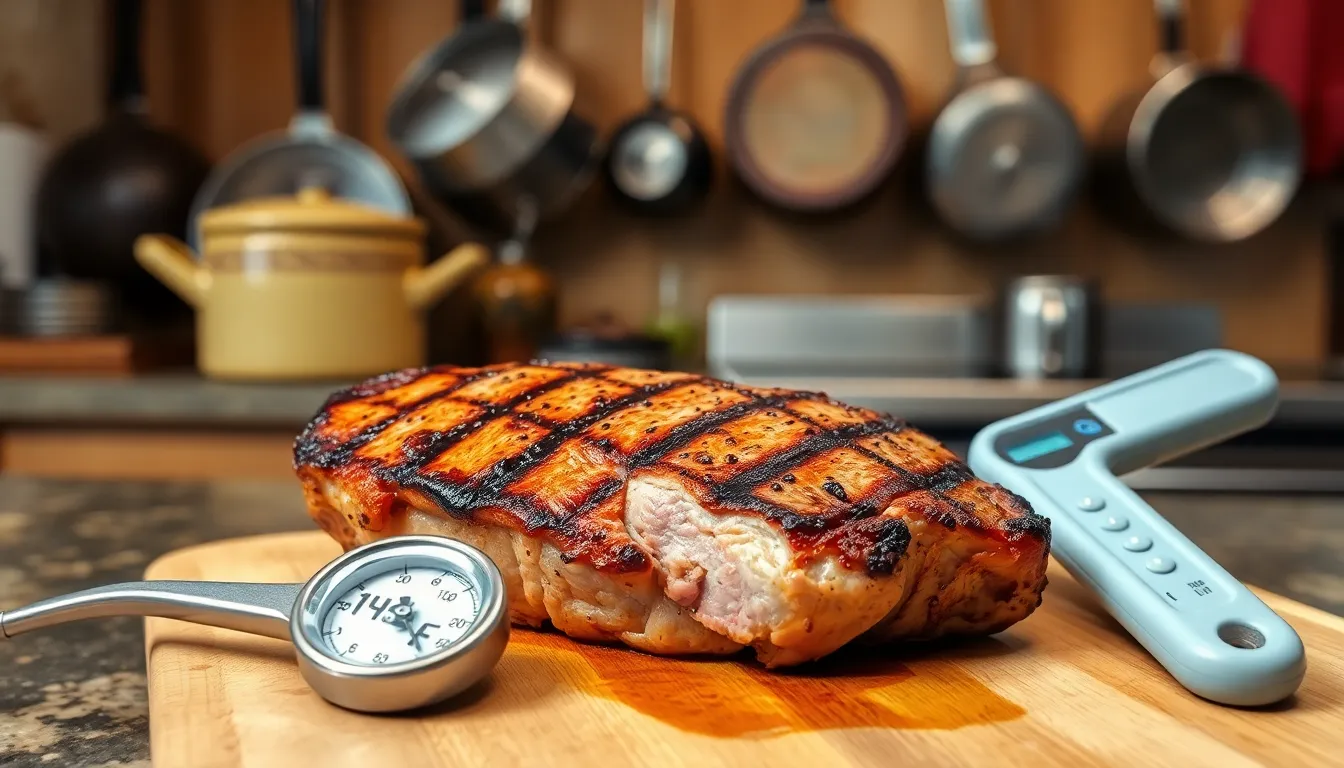Table of Contents
ToggleWhen it comes to pork, the age-old debate of whether pink is the new black can leave many scratching their heads. Picture this: you’re at a barbecue, the aroma of sizzling pork fills the air, and your friend turns to you with a horrified look, pointing at the slightly pink center of your juicy chop. Is it a culinary delight or a ticket to the emergency room?
In today’s culinary landscape, the rules are changing faster than a chef can flip a burger. With modern cooking methods and improved food safety standards, that blush of pink might just be a sign of deliciousness rather than danger. So, can you eat pink pork without fear? Let’s dig into the juicy details and separate fact from fiction, ensuring your next meal is both safe and scrumptious.
Understanding Pink Pork
Pink pork raises questions about its safety in various culinary contexts. Awareness of its implications is crucial for enjoying meals without concern.
What Does Pink Pork Mean?
Pink pork refers to cooked pork that retains a slight blush in the center. This coloration can occur due to various factors, including cooking methods and meat cuts. For instance, the USDA states that pork should reach an internal temperature of 145°F, which may leave it pink yet safe to eat. Moreover, certain breeds of pigs may naturally yield meat with a pinkish hue. Identifying pink pork’s meaning helps consumers make informed decisions about its consumption.
Common Myths About Pink Pork
Many misconceptions about pink pork persist. One common myth suggests that any pink color indicates undercooked meat. In reality, pork can be perfectly cooked and still appear pink. Another myth claims that eating pink pork always leads to foodborne illness. This assumption overlooks advancements in food safety that ensure pork can be both delicious and safe when properly prepared. Dispelling these myths allows individuals to enjoy pink pork confidently without unnecessary fear.
Safety Guidelines for Eating Pork

Understanding the safety guidelines when consuming pork helps individuals make informed choices. Knowledge of proper cooking techniques and recognizing signs of doneness ensures a safe and enjoyable dining experience.
Cooking Temperatures for Pork
Cooking pork to the right temperature is crucial for safety. The USDA recommends an internal temperature of 145°F for whole cuts of pork, followed by a rest time of three minutes. Ground pork requires a higher temperature of 160°F to eliminate harmful bacteria. Cooking methods like grilling, roasting, or pan-frying can achieve these temperatures effectively. Using a food thermometer provides accurate readings, ensuring that pork is cooked thoroughly and safely.
Signs of Properly Cooked Pork
Properly cooked pork exhibits distinct characteristics. A slight blush in the center often indicates doneness for whole cuts when cooked to the recommended temperature. Juices should run clear, while the meat should feel firm yet slightly springy to the touch. Looking for even browning on the outside can also signify thorough cooking. Trusting visual cues, alongside temperature checks, enhances confidence in consuming pink pork safely.
Nutritional Aspects of Pork
Pork offers a variety of nutritional benefits that can enhance a balanced diet. It’s a rich source of protein, essential for muscle growth and repair. Vitamins such as B6 and B12 in pork support energy metabolism and nervous system health. Iron found in pork contributes to the production of hemoglobin, aiding oxygen transport in the bloodstream. Zinc in pork also plays a crucial role in immune function and wound healing.
Health Benefits of Eating Pork
Eating pork provides multiple health benefits that support overall well-being. Lean cuts of pork, like tenderloin and loin chops, yield high protein content with fewer calories. These cuts maintain low fat levels while delivering necessary amino acids, helping muscle maintenance. Additionally, pork contains vitamin B1, which is vital for converting carbohydrates into energy. Studies have linked moderate pork consumption to improved satiety, which can aid in weight management.
Nutritional Comparison with Other Meats
Pork’s nutritional profile compares favorably with other meats, making it a versatile option. Chicken, often regarded as a lean meat choice, typically contains similar protein levels but less fat in certain cuts. Beef, although rich in iron and zinc, provides higher fat content, especially in cuts like ribeye. In contrast, pork offers a balance between flavor and nutrition, with cuts like pork shoulder delivering richness while still being a good protein source. By incorporating pork into meals, individuals benefit from varied flavor profiles and essential nutrients that contribute to a balanced diet.
Culinary Perspectives on Pink Pork
Pink pork has gained attention for its potential as a delicious, safe option in various culinary contexts.
Popular Dishes Featuring Pink Pork
Many dishes showcase pink pork’s unique flavor and texture. Consider carnitas, where slow-cooked pork shoulder retains a slight blush while offering bold flavors. Additionally, pulled pork sandwiches often present a tender, pink center that enhances the taste experience. Pork chops prepared with a rosemary and garlic rub can be juicy and pink, creating a delightful dish when cooked to the right temperature. Barbecue pork ribs, when smoked correctly, exhibit a pink hue, which indicates a flavorful, tender meal. Meals like these highlight how pink pork enhances traditional dishes.
Chef Recommendations on Cooking Pork
Chefs emphasize proper techniques to achieve perfectly cooked pink pork. Monitoring internal temperatures is key, with a target of 145°F for whole cuts and 160°F for ground pork. Utilizing a meat thermometer ensures accurate readings, protecting against undercooked meat. Many chefs recommend letting pork rest after cooking, allowing juices to redistribute while the residual heat continues to cook the meat slightly. Using techniques like brining can add moisture and flavor, further enhancing the dining experience. Experienced cooks often suggest grilling or pan-searing to create appealing crusts while maintaining a flavorful pink center.
Enjoying pink pork can be a safe and flavorful experience when proper cooking techniques are followed. With the USDA guidelines in mind and an understanding of doneness indicators, individuals can confidently savor meals featuring pink pork.
The culinary versatility of pork allows it to shine in various dishes while providing essential nutrients. By embracing the nuances of cooking and recognizing the safety measures, diners can appreciate the unique taste and texture that pink pork offers. So next time you see that slight blush in your pork, remember it’s not just safe, but delicious too.





